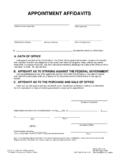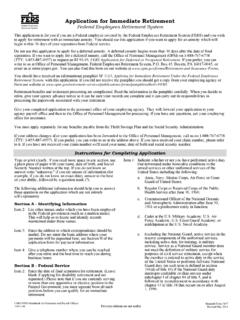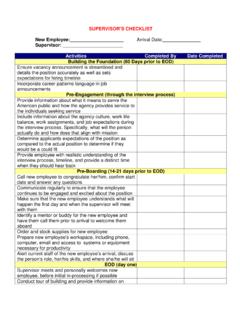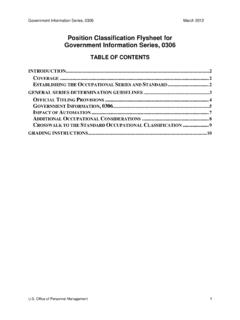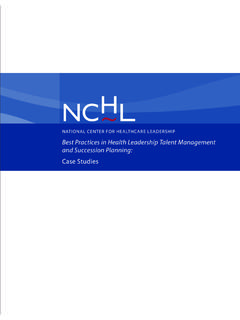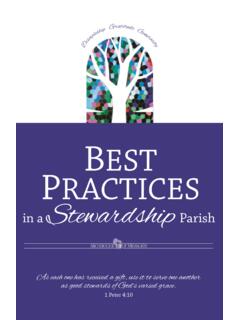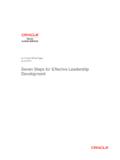Transcription of Best ractices Mentoring - opm.gov
1 September 2008 Be s t Pr a c t i c e s: Me n t o r i n g Table of Contents INTRODUCTION 2 Why Organizations Implement Mentoring Programs 2 Types of Mentors 4 Formal and Informal Mentoring Programs 4 Benefits of Mentoring for the Mentor 4 Benefits of Mentoring for the Prot g 5 THINGS TO CONSIDER IN DEVELOPING AND IMPLEMENTING 6 A FORMAL Mentoring PROGRAM 6 Developing a Mentoring Program 6 Implementing a Mentoring Program 9 OTHER TYPES OF Mentoring 15 APPENDIX A: KIRKPATRICK MODEL 17 RESOURCES FOR Mentoring 21 2 Introduction Mentoring is usually a formal or informal relationship between two people a senior mentor (usually outside the prot g s chain of supervision) and a junior prot g.
2 Mentoring has been identified as an important influence in professional development in both the public and private sector. Within the Federal government, Mentoring is often a component of different types of development, including comprehensive career development programs like the Senior Executive Service Candidate Development Program (SESCDP), the Executive Leadership Program (ELP) and the Presidential Management Fellowship (PMF) Program. The major function of Mentoring within these programs is to promote the prot g s development in specific areas and to facilitate successful completion of the program.
3 While these Mentoring relationships can produce positive developmental and organizational outcomes, both Mentoring programs and relationships sometimes fail due to a variety of causes and problems ( , lack of participation, no leadership involvement, poor planning, unrealistic expectations, and fuzzy goals). Successful Mentoring programs require proper understanding, planning, implementation and evaluation. In addition to the stand-alone benefits of Mentoring , on October 30, 2004, the President signed the Federal Workforce Flexibility Act of 2004, Public Law 108-411, into law.
4 The Act makes several significant changes in the law governing the training and development of Federal employees, supervisors, managers, and executives. One major change requires agencies, in consultation with OPM, to provide training to managers on Mentoring employees. In collaboration with the Department of State, Department of Energy, Nuclear Regulatory Commission, Environmental Protection Agency, National Aeronautics and Space Administration, Alcohol, Tobacco and Firearms, and Corporation for National and Community Service, noted for their innovative and effective Mentoring programs and best practices, we have developed this document as a tool to assist agencies in creating a business case for Mentoring and as an outline of the critical steps in developing and implementing a formal Mentoring program.
5 Why Organizations Implement Mentoring Programs More and more organizations are creating formal Mentoring programs for various reasons. From increased morale to increased organizational productivity and career development, the benefits of an organization that actively supports Mentoring are numerous. However, successful Mentoring programs do not just happen. Organizations must first make a strong business case to demonstrate why the organization should devote the time, attention and resources required to make a formal Mentoring process work. Reasons for establishing a Mentoring program must be linked to the organization's business goals.
6 For example, an agency forecasting tremendous growth in a specific job series may want a Mentoring program to help prepare high-potential employees for future managerial positions in that series. Also, an organization planning a reorganization may be interested in a Mentoring program to help facilitate continuity of organizational 3performance. Listed below are some reasons why agencies choose to establish Mentoring programs. As part of the Onboarding process -- Mentoring helps new recruits, trainees or graduates settle into the organization; Skills Enhancement -- Mentoring enables experienced, highly competent staff to pass their expertise on to others who need to acquire specified skills; Professional Identity -- when younger employees are early in their careers, they need help understanding what it means to be a professional in their working environment.
7 Professionals embody the values of the profession and are self-initiating and self-regulating. Mentors play a key role in defining professional behavior for new employees. This is most important when employees first enter the federal workforce; Career Development -- Mentoring helps employees plan, develop, and manage their careers. It also helps them become more resilient in times of change, more self-reliant in their careers and more responsible as self-directed learners; Leadership and Management Development -- Mentoring encourages the development of leadership competencies.
8 These competencies are often more easily gained through example, guided practice or experience than by education and training; Education Support -- Mentoring helps bridge the gap between theory and practice. Formal education and training is complemented by the knowledge and hands-on experience of a competent practitioner; Organizational Development and Culture Change -- Mentoring can help communicate the values, vision and mission of the organization; a one-to-one relationship can help employees understand the organizational culture and make any necessary changes; Customer Service -- Mentoring assists in modeling desired behaviors, encouraging the development of competencies in support of customer service, and above all, cultivating the right attitudes.
9 Staff retention -- Mentoring provides an encouraging environment through ongoing interactions, coaching, teaching, and role modeling that facilitates progression within the organization; Mentoring has been found to influence employee retention because it helps establish an organizational culture that is attractive to the top talent clamoring for growth opportunities. Mentoring is a tangible way to show employees that they are valued and that the company s future includes them; Recruitment -- Mentoring can enhance recruitment goals by offering additional incentives to prospective employees; and Knowledge Management/Knowledge Transfer -- Mentoring provides for the interchange/exchange of information/knowledge between members of different organizations.
10 4 Types of Mentors There are mainly four types of mentors: Career Guide -- promotes development through career guidance, counseling and visibility; Information Source -- provides information about formal and informal expectations; Friend -- interacts with the prot g socially and provides information about people; and Intellectual Guide -- promotes an equal relationship, collaborates on research projects and provides constructive feedback and criticism. When planning and developing Mentoring programs, agencies must consider the types of mentors and decide which type(s) of help will be most appropriate given the program goals.

